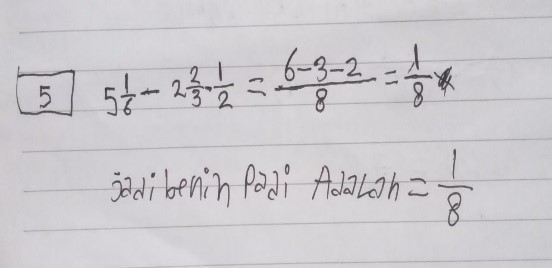
Analysis of students error in completing hots questions on fruction additional and subtraction operations class V SDN Karangtengah I
Abstract
This study aims to 1) to describe the mistakes made by fifth graders at SDN Karangtengah I in solving HOTS questions on the addition and subtraction of fractions in grade V. 2) To describe the factors that caused fifth graders at SDN Karangtengah I to make mistakes in solve HOTS questions on the material of addition and subtraction of fractions in class V. This type of research is descriptive qualitative, with data sources from students and teachers of class V SDN Karangtengah I. Data collection techniques use written tests, interviews, observations and documentation. While the data analysis technique used is the analysis of the Miles and Huberman model which consists of data collection, data reduction, data display, and drawing conclusions. The results of this study indicate that 1) in solving the HOTS questions for adding and subtracting fractions, the fifth-grade students of SDN Karangtengah I make errors in encoding error with a percentage of 41.94 percent, process skill errors with a percentage of 37.9 percent, transformation errors with a percentage of 13, 71 percent, conprehension errors with a percentage of 4.84 percent, and reading errors with a percentage of 1.61 percent. 2) The factors that cause students to make mistakes in solving HOTS questions on addition and subtraction material are 2 factors, namely external factors and internal factors. The external factors that cause students to make mistakes because the learning process does not get used to the use of HOTS questions. Furthermore, the internal factors that cause students to make mistakes are a) the encoding error indicator is that students do not know the next step after carrying out the calculation process and students do not know how to conclude answers; b) the process skill error indicator is that students' numeracy skills are low, students do not know the concepts of fractional arithmetic operations and porogapit; c) the transformation error indicator is that students cannot determine arithmetic operations; d) on the comprehension error indicator, students have difficulty in writing down the information contained in the questions, students do not write down the information contained in the questions and students are in a hurry to take the test; e) the reading error indicator is that students are not careful in reading the questions and students are not able to understand the keywords or sentences in the questions; and the most common internal factor is the intellectual ability of students and students experience errors in the previous stage.
Full Text:
PDFReferences
Anderson, & Krathwohl. (2016). Bloom’s Taxonomy Revised Understanding the New Version of Bloom’s Taxonomy.
Bahir, R. A., & Mampouw, H. L. (2020). Identifikasi Kesalahan Siswa SMA dalam Membuat Pemodelan Matematika dan Penyebabnya. Jurnal Cendekia : Jurnal Pendidikan Matematika, 4(1), 72–81. https://doi.org/10.31004/cendekia.v4i1.161
Dinda Amalia, & Windia Hadi. (2020). Analisis Kesalahan Siswa Dalam Menyelesaikan Soal Hots Berdasarkan Kemampuan Penalaran Matematis. Transformasi : Jurnal Pendidikan Matematika Dan Matematika, 4(1), 219–236. https://doi.org/10.36526/tr.v4i1.904
Modul Pelatihan Kurikulum 2013 Sekolah Dasar/Madrasah Ibtidaiyah, Kementerian Pendidikan dan Kebudayaan (2018).
Handayani, T., Hartatiana, H., & Muslimahayati, M. (2020). Analisis Kesalahan Siswa dalam Menyelesaikan Soal Cerita Materi Barisan dan Deret Aritmatika. PHI: Jurnal Pendidikan Matematika, 4(2), 160. https://doi.org/10.33087/phi.v4i2.111
Hasyim, M., & Andreina, F. K. (2019). Analisis High Order Thinking Skill (HOTS) Siswa Dalam Menyelesaikan Soal Open Ended Matematika. FIBONACCI: Jurnal Pendidikan Matematika Dan Matematika, 5(1), 55. https://doi.org/10.24853/fbc.5.1.55-64
Hidayah, S. (2016). Analisis Kesalahan Siswa Dalam Menyelesaikan Soal Cerita SPLDV Berdasarkan Langkah Penyelesaian Polya. Tahun 2016-ISSN 2528-259X 182 | Prosiding Seminar Nasional Pendidikan Matematika, 1, 182–190.
Kunanti, E. S. (2021). Penyusunan Pengembangan Penilaian Berbasis HOTS. Prosiding Seminar Nasional Pembelajaran Bahasa Dan Sastra Indonesia (PBSI)-III, 19–26.
Mulyani, M., & Muhtadi, D. (2019). Analisis Kesalahan Siswa Dalam Menyelesaikan Soal Trigonometri Tipe Higher Order Thinking Skill Ditinjau Dari Gender. Jurnal Penelitian Dan Pembelajaran Matematika, 12(1). https://doi.org/10.30870/jppm.v12i1.4851
Murtiyasa, B., & Wulandari, V. (2020). Analisis Kesalahan Siswa Materi Bilangan Pecahan Berdasarkan Teori Newman. Aksioma: Jurnal Program Studi Pendidikan Matematika, 9(3), 713. https://doi.org/10.24127/ajpm.v9i3.2795
Sa’adah, K., & Pramesti, S. L. D. (2022). Analisis Kesalahan Siswa Berdasarkan Tahapan Newman Dalam Penyelesaian Soal Cerita Bangun Ruang Limas Dan Prisma. ProSANDIKA UNIKAL (Prosiding Seminar Nasional Pendidikan Matematika Universitas Pekalongan), 453–462.
Sofyan, F. A. (2019). Implementasi HOTS Pada Kurikulum 2013. INVENTA, 3(1), 1–9. https://doi.org/10.36456/inventa.3.1.a1803
Sugiono, M. U. (2014). Profil Perilaku Prososial Anak Usia Dini Dan Implikasinya Terhadap Program Bimbingan Pribadi-Sosial : Studi Deskriptif Kualitatif di TK Bintang Mulia. Universitas Pendidikan Indonesia.
Viani, C. F., Setyowati, R. D., & Zuhri, M. S. (2020). Analisis Kesalahan Siswa SMP Berdasarkan Kriteria Watson dalam Menyelesaikan Soal Metematika Bertipe High Order Thinking Skills (HOTS) Ditinjau dari Gaya Belajar. Imajiner: Jurnal Matematika Dan Pendidikan Matematika, 2(5), 372–381. https://doi.org/10.26877/imajiner.v2i5.6115
Refbacks
- There are currently no refbacks.
International Journal of Insight for Mathematics Teaching is licensed under
Creative Commons Attribution-ShareAlike 4.0 International (CC BY-SA 4.0)



1.png)
1.png)
3.png)
